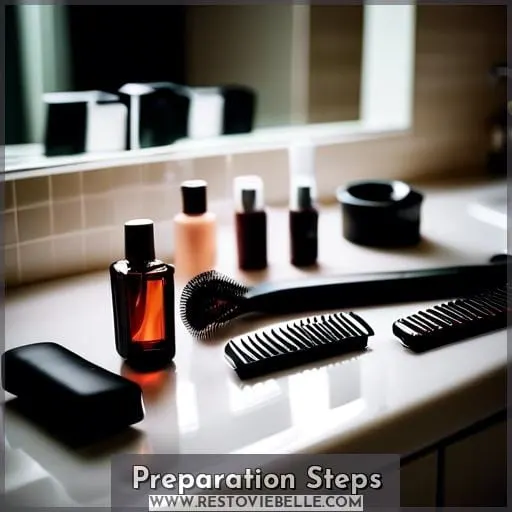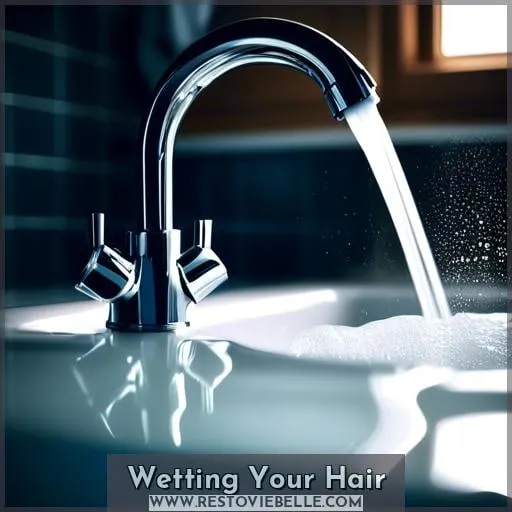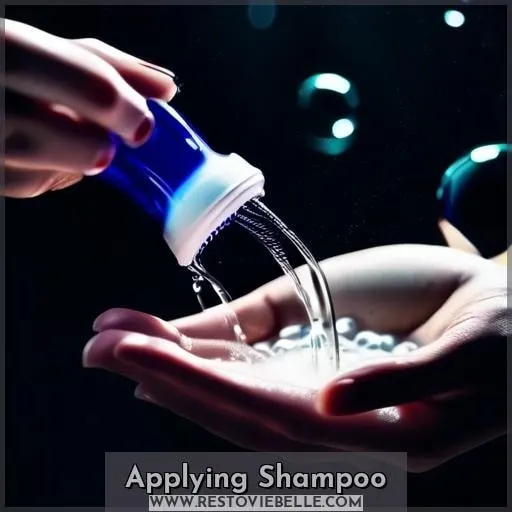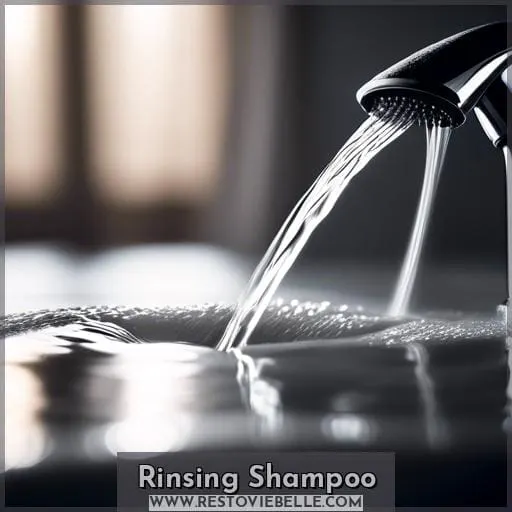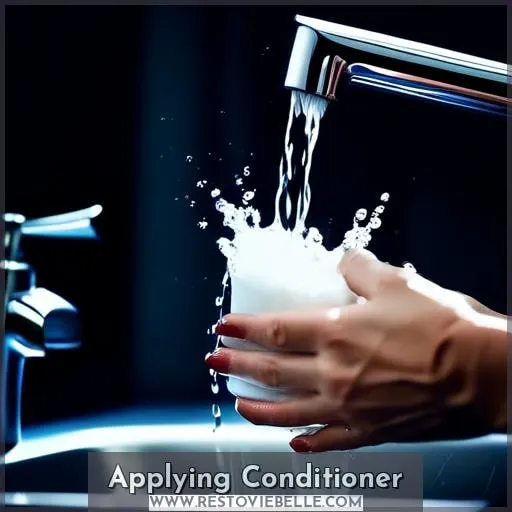This site is supported by our readers. We may earn a commission, at no cost to you, if you purchase through links.
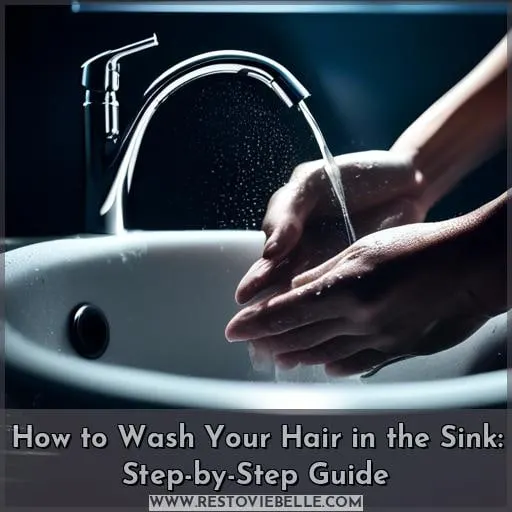 Gather your supplies, roll up your sleeves, and get ready to take control of your hair care routine.
Gather your supplies, roll up your sleeves, and get ready to take control of your hair care routine.
Washing your hair in the sink isn’t just about saving time; it’s about adapting to your needs, whether you’re conserving water, avoiding a full shower, or managing a new hairstyle.
With the right technique, you can achieve salon-fresh locks right at your basin. Let’s dive into the steps to ensure your sink hair wash is as effective as it is efficient.
Yes, you can wash your hair in the sink by bending over, wetting your hair with warm water, applying shampoo to the roots, and then rinsing thoroughly. After shampooing, apply conditioner to the ends, let it sit, and rinse out completely.
Table Of Contents
- Key Takeaways
- Preparation Steps
- Positioning for Comfort
- Wetting Your Hair
- Applying Shampoo
- Rinsing Shampoo
- Applying Conditioner
- Final Rinse and Drying
- Frequently Asked Questions (FAQs)
- How can I prevent water from splashing everywhere when washing my hair in the sink?
- What should I do if I have back or neck pain and find it difficult to lean over the sink?
- Can I wash my hair in the sink with hair extensions or a weave, and if so, how should I do it differently?
- Are there any specific hair care products recommended for use when washing hair in the sink to avoid tangles and knots?
- How can I effectively wash my hair in the sink if I have limited mobility or cannot use my hands extensively?
- Conclusion
Key Takeaways
- Ensure the sink is at a comfortable height and use a sprayer for even saturation of the hair; a step stool can be used if the sink is too high.
- Apply shampoo by first lathering in hands, then massage into the scalp and work down to the tips, being careful to avoid getting soap in the eyes.
- Rinse shampoo thoroughly until water runs clear, ensuring all shampoo is washed out, and consider using a hair catcher to prevent clogs.
- Apply conditioner from the ears down to avoid the scalp, leave in for 1-5 minutes, and rinse with cool water before towel drying hair gently.
Preparation Steps
When preparing to wash your hair in the sink, it’s important to choose the right sink and adjust the water temperature for comfort and effectiveness.
You’ll want to select a sink that has a sprayer and is at a comfortable height to avoid straining your back or neck. Make sure to roll up your sleeves or remove your shirt to keep them dry, and place a towel around your neck to protect your clothing.
Adjust the water temperature to warm, which is ideal for cleansing without causing discomfort. Use a step stool if the sink is too high to ensure you can reach comfortably without overextending yourself.
Selecting the Right Sink
When preparing to wash your hair in the sink, it’s essential to start by selecting the right sink for the task. At the outset, you should look for a sink that not only fits your height comfortably but also comes equipped with a sprayer to facilitate the washing process.
This initial step is crucial as it sets the stage for a more efficient and comfortable hair washing experience.
Choosing the appropriate sink for hair washing involves considering several factors to ensure a smooth and effective process. Your sink choice should prioritize comfort level and proper height to prevent any unnecessary strain on your body.
An accessible sprayer is a valuable feature, as it allows for easier saturation of the hair, especially when targeting specific areas like the back of the neck or the sides. Adequate lighting is also important to help you see clearly and avoid missing any spots during the washing and conditioning stages.
For those with tangled hair or natural hair, the sink’s depth and size can make a significant difference. A larger sink may accommodate the full length of the hair better, reducing the risk of knots and making it easier to manage during the wash.
Additionally, if you plan to perform deep conditioning treatments, having enough space to apply and rinse the product thoroughly is essential.
In summary, when selecting a sink for hair washing, consider the sink’s height, whether it has a sprayer, the lighting conditions, and the size of the sink to ensure it can accommodate your hair care needs effectively.
Adjusting Water Temperature
Adjusting the water temperature is crucial for a comfortable and effective hair washing experience. Lukewarm water, approximately 100°F, is ideal as it helps to activate shampoo cleansers without stripping hair of its natural oils or causing scalp irritation.
This temperature balances effective cleansing with maintaining hair and scalp health.
Hot water can dehydrate the scalp and lead to hair damage, while cold water mightn’t cleanse effectively and could constrict scalp capillaries. Therefore, finding the right water temperature ensures your hair is cleaned gently and thoroughly, avoiding discomfort or damage to your hair and scalp.
Positioning for Comfort
When washing your hair in the sink, it’s important to ensure you’re positioned comfortably to avoid any strain.
Start by placing a towel around your neck to protect your clothing and skin from getting wet.
If the sink is too high, don’t hesitate to use a step stool for better reach and to maintain a comfortable posture.
Using a Step Stool
Adjusting the water temperature and ensuring the sink is at a comfortable height are important first steps.
When the sink is too high, using a step stool can provide the necessary boost to comfortably reach the basin. This simple tool can make a big difference in your hair washing routine, especially if you’re dealing with mobility issues or if children are involved.
Step stools designed for safety, like those with a self-retracting design, ensure stability and minimize potential hazards. They’re a practical addition to any bathroom or kitchen, offering height adjustment necessity and stool stability.
When selecting a step stool, look for features that ensure it won’t slip and can support a significant amount of weight. This is crucial to avoid accidents in a potentially wet and slippery environment.
For those unable to use a step stool, alternative tools or methods, such as a shower chair or assistance from another person, may be necessary. Remember, the goal is to wash your hair without creating a mess or risking injury.
Towel Placement
After securing a step stool to reach the sink comfortably, you’ll want to drape a towel around your neck to protect your clothing and skin from getting wet.
Opting for a towel with high absorbency and soft material ensures comfort and efficiency. The size of the towel should be ample enough to cover your shoulders and chest, preventing any splashes from reaching your clothes.
Choosing a towel color that doesn’t easily show stains can also be practical for repeated use. Proper towel placement not only keeps you dry but enhances the hair washing experience by adding a layer of convenience and control.
Wetting Your Hair
Washing your hair in the sink can be a convenient alternative to a full shower, especially when you’re short on time or need to avoid getting your body wet.
To start the process of wetting your hair, first, lean forward over the sink, allowing the back of your neck to be exposed under the faucet. Then, turn on the warm water and use either your hands or a cup to thoroughly saturate your hair, making sure to cover all areas including the back, sides, and front.
This initial step is crucial for ensuring your hair is evenly wet before applying shampoo, setting the stage for a successful and efficient wash.
Flipping Hair Forward
When washing your hair in the sink, you’ll need to lean forward over the basin, flipping your hair down to ensure the back of your neck is positioned under the faucet.
- Adjust the water temperature to warm to prevent shock to the scalp and minimize product buildup.
- Use a gentle stream from the faucet or a sprayer to avoid tangled hair and ensure even saturation.
- Support your neck and back as needed to prevent strain during the process.
Saturating Hair Evenly
To ensure your hair is thoroughly wet before applying shampoo, follow these steps:
- Lean over the sink comfortably with your hair flipped forward to allow for even saturation.
- Use the sprayer to methodically wet the hair from the back of the neck to the sides.
- Continue by wetting the hair above the forehead.
- Ensure that every strand is sufficiently dampened before moving on to shampooing.
Applying Shampoo
When washing your hair in the sink, it’s essential to dispense the right amount of shampoo—about a quarter-sized dollop for most hair types.
Start by lathering the shampoo in your hands, then focus on massaging it into your scalp, as this is where oil and dirt tend to accumulate.
From there, work the shampoo down to the tips of your hair to ensure a thorough cleanse.
Dispensing the Right Amount
You’ll need to start by dispensing a quarter-sized dollop of shampoo into your palm. This accurate measurement ensures you’re using the right shampoo quantity, balancing cleanliness with care for your hair’s health.
Focusing on the Scalp
Focusing on the scalp when applying shampoo is crucial for effective hair cleansing. Starting at the hairline, you’re aiming to massage the shampoo down toward the ends, ensuring the scalp, where oil production is highest, receives the most attention.
Extending to Hair Tips
After lathering the shampoo in your hands, you’ll want to ensure every strand benefits from the cleansing by working the shampoo through to the very tips of your hair.
- Focus on scalp cleansing for a healthy foundation.
- Adjust water temperature for optimal hair saturation.
- Use precise towel placement to manage moisture post-rinse.
Rinsing Shampoo
When it comes to rinsing shampoo out of your hair in the sink, it’s crucial to ensure the water runs clear to avoid any residue.
You’ll want to avoid getting soap in your eyes, so be cautious during this process.
Keep rinsing until you’re confident that all the shampoo has been washed out, ensuring your hair is thoroughly clean.
Ensuring Clear Water Runoff
Rinsing shampoo thoroughly from your hair is essential to prevent buildup and ensure cleanliness.
Position yourself to optimize water pressure and the sink’s shape for effective rinsing.
Consider the drain location and type, using a hair catcher to avoid clogs.
This method promotes control and innovation, adapting to your unique hair care needs.
Avoiding Eye Contact
When rinsing shampoo from your hair in the sink, it’s important to keep your eyes closed to prevent soap from entering and causing discomfort.
- Tilt your head back slightly to direct the flow away from your face.
- Use your hand as a shield above your brows.
- Blink frequently to clear any stray droplets.
- Consider wearing a visor for added eye protection.
- Be mindful of scalp sensitivity and potential soap allergies.
Applying Conditioner
When it comes to applying conditioner during a sink hair wash, it’s all about technique and timing.
Start by dispensing a quarter-sized dollop of conditioner into your palm, then rub your hands together before applying it to your hair, focusing from your ears down. This approach helps avoid weighing down your roots and ensures the ends of your hair, which are often the driest, receive the moisture they need.
Let the conditioner sit in your hair for one to five minutes before rinsing with cold water to seal the cuticle and enhance shine.
Conditioner Quantity and Application
Following the thorough rinsing of shampoo from your hair, you’ll need to apply conditioner to keep your strands hydrated and manageable.
Dispensing a quarter-sized dollop of conditioner, focus on applying it from the mid-lengths to the ends of your hair, steering clear of the scalp to avoid weighing your hair down or causing excess oiliness.
Timing for Conditioner
After you’ve applied the conditioner, it’s important to leave it on your hair for 1 to 5 minutes to allow the ingredients to penetrate and moisturize the strands effectively.
- Experiment with leave-in conditioner for added hydration.
- Consider deep conditioning for intensive repair.
- Use clarifying shampoo prior for optimal scalp treatment.
- Integrate a hair mask weekly for strength.
- Time your routine to balance hair health and daily efficiency.
Final Rinse and Drying
When it comes to the final rinse and drying phase of washing your hair in the sink, using cool water for the last rinse can be beneficial. This helps to close the hair cuticles, making your hair smoother and less prone to frizz.
After rinsing, gently towel dry your hair by patting or lightly squeezing the strands with a towel, rather than rubbing, to minimize damage and breakage. This approach ensures that your hair retains moisture while reducing the risk of frizz, setting the stage for a healthy drying process.
Using Cool Water
When drying your hair, consider a final rinse with cool water. Using cool water for the final rinse after conditioning can help close the hair’s cuticle. This may enhance shine and smoothness. It’s also believed that a cool water rinse can help seal in moisture from the conditioner.
Towel Drying Techniques
When towel drying your hair after the final rinse, it’s important to use a gentle technique to avoid causing damage to your wet strands, which are more vulnerable to breakage.
Start by gently squeezing out excess water from your hair with your hands, then take a soft microfiber towel and blot or wrap your hair without rubbing, as this can lead to frizz and breakage.
Microfiber towels are preferred because they’re more absorbent and create less friction compared to regular cotton towels. Remember to avoid vigorous rubbing and instead opt for a gentle squeezing or patting motion to protect your hair’s integrity.
Frequently Asked Questions (FAQs)
How can I prevent water from splashing everywhere when washing my hair in the sink?
To prevent water splashing when washing hair in the sink, adjust the water flow to a gentle stream.
Use controlled movements and ensure the water hits your hair directly.
What should I do if I have back or neck pain and find it difficult to lean over the sink?
Consider using a hair washing tray or inflatable basin to support your neck and back while washing your hair.
Try no-rinse shampoo options to minimize bending.
Can I wash my hair in the sink with hair extensions or a weave, and if so, how should I do it differently?
You can indeed wash hair extensions or a weave in the sink, but it’s like walking a tightrope—precision and care are key.
Start by gently brushing to avoid tangles. Use lukewarm water and a sulfate-free shampoo, lathering gently, especially near bonds or clips.
Condition from mid-length to ends, avoiding roots and bonds. Rinse thoroughly and air dry.
Are there any specific hair care products recommended for use when washing hair in the sink to avoid tangles and knots?
For avoiding tangles and knots when washing hair in the sink, try Controlled Chaos detangling shampoo and conditioner. Specifically designed for curly, frizzy hair, these products offer nourishment and detangling properties.
They make hair management easier and leave your curls soft, smooth, and defined.
How can I effectively wash my hair in the sink if I have limited mobility or cannot use my hands extensively?
Consider using a portable basin or inflatable sink that allows you to wash your hair while seated.
Attach a handheld sprayer to the faucet for easier rinsing.
Use a no-rinse shampoo cap if needed.
Conclusion
Imagine you’ve just returned from a brisk morning run, and time is of the essence.
You’ve efficiently washed your hair in the sink, conserving both water and precious minutes.
With these steps, you’ve mastered the art of sink hair washing, ensuring your locks remain as vibrant and healthy as if you’d just stepped out of a salon.
Keep it up, and you’ll always look your best!
